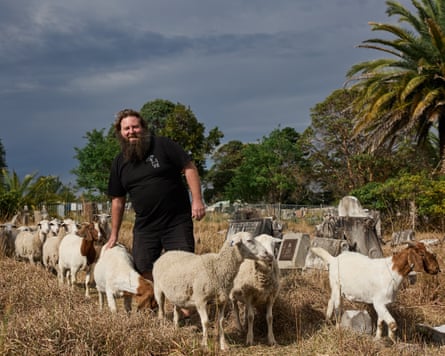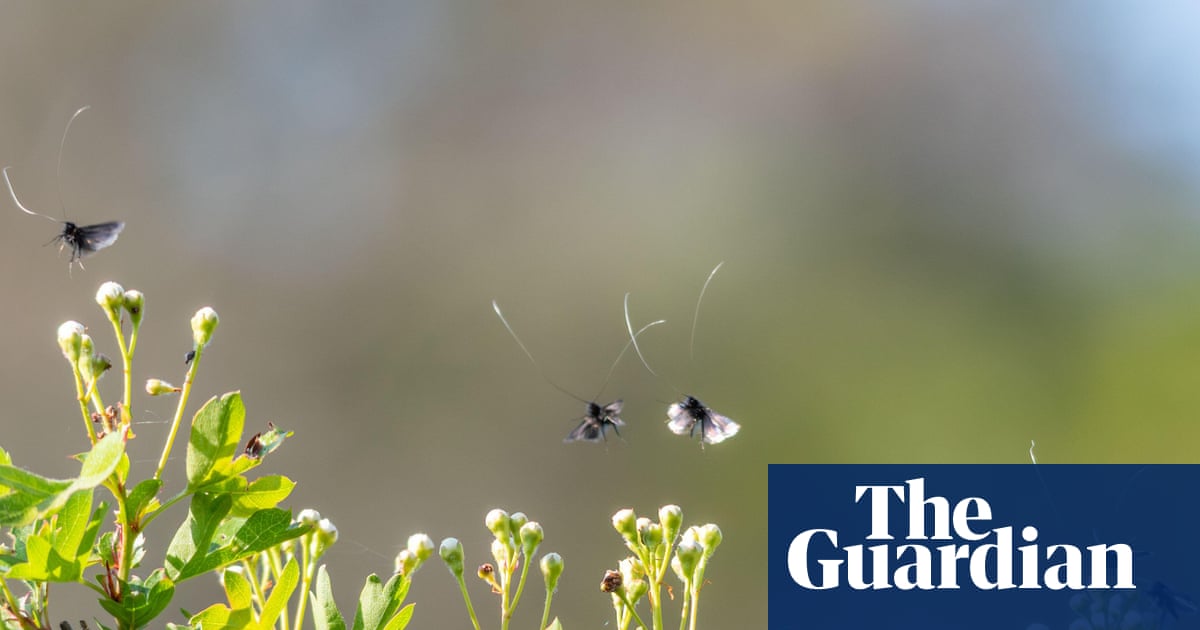PROTECT YOUR DNA WITH QUANTUM TECHNOLOGY
Orgo-Life the new way to the future Advertising by AdpathwayCraig Homan’s herd of hungry goats has a busy schedule.
A wet winter and an early spell of warmth have turbocharged vegetation growth in Sydney, creating a pipeline of work for the creatures whose skills as unstoppable eating machines make them consummate low-maintenance weed clearers, meadow mowers and bush bashers.
This week, his 43 Boer goats – chosen for their large size and short hair, ideal for not getting tangled in blackberry bushes – are munching their way through the grass around headstones at Rookwood cemetery, in western Sydney.
Homan, who owns Sydney Eco Land Clearing, uses hard fences to corral the “smart and crafty” animals into a single area and provides water, shelter and supplementary food. Then, he leaves them alone.
“They clear about two acres of dense weeds in two weeks with no tipping fees, no chemicals, no machinery, no fuel, no nothing,” he says of the goats.
They can nimbly take on uneven ground and steep hillsides and will clear right up to a gravestone or tree trunk, leaving no inch unchewed. Their soft hooves mean they do not damage slopes and banks – or the 130-year-old graves over which they lightly trample – and their droppings fertilise the ground as they go.

Once the animals finish, a team removes broken branches and blows away any droppings from the monuments, Jake Latimer says, the grounds manager for Metropolitan Memorial Parks at Rookwood. Their droppings have been known to trigger complaints, but the goats tend to older, less-visited grave sites, away from the 190-hectare park’s current burial areas.
“The goats give us time to concentrate on the prominent areas,” he says.
They will eat everything in their path besides wood, and a special enzyme in their stomachs even breaks down seeds, which helps to prevent weed regrowth. Invasive weeds such as lantana and privet are small fry for the ruminants, which make a beeline for the exotics’ higher sugar content before moving on to less-sweet grasses and native weeds.
Sign up: AU Breaking News email
“They are like children, they go for the sugary things first,” Homan says. That’s why he has added 13 sheep to the herd at Rookwood – the job is heavy on grass, which is preferred by sheep, leaving the weeds for the goats.
The goats’ next job is to eat to their hearts’ content in the name of bushfire mitigation at a creek bed in Castle Hill.

“We eliminate the fuel load wherever we put the goats. It’s a win-win, people want to clear their block but you’re also getting rid of the fuel for bushfires,” Homan says.
His is one of a number of goat herds on the frontline of bushfire preparedness in New South Wales, munching through acres of undergrowth on difficult terrain as part of a sustainable hazard reduction trial.
after newsletter promotion
A herd of 120 goats has just completed a three-week stint clearing thick grass and scrub in hard-to-reach areas for the state’s Rural Fire Service on the lower north coast.
The trial has been in place since 2021 and is a direct result of the inquiry into the black summer bushfires, which recommended research into the effectiveness of grazing for hazard reduction. The University of Melbourne is collecting data from the trial and will formally analyse its impact, but so far the RFS preparedness lead, Kim Smith, does not have a bad word to say about the goats.
“We honestly haven’t had any negative results. It’s something we’ve shown can really be effective,” she says. “It’s a positive to come out of a negative situation.”
The RFS has been testing the strategy all year round at locations across NSW. Unlike machinery, trucks and burning, the goats work well in wet weather and it’s hoped they will become a permanent part of the service’s bushfire safety strategy.

Hazard reduction burns can be carried out only about once every seven years, she says, but the goat herds can be sent to regraze areas as many times as needed. And the animals make light work of rocky terrain that would normally need the help of aircraft and remote firefighting teams.
The area they can tackle is limited by the fencing needed to stop any escapes – landscaping goats once ending up on Melbourne’s Eastlink tollway, and they can be adept at evading barriers. Their impact is also constrained by the small number of goat vendors, she says.
For now, the goats will not replace traditional hazard reduction burns, but Smith says they’re “a tool in the toolbox” the service would definitely like to have permanently.

“They’re a bit of a speciality tool. It’s not something we could utilise statewide or on a broad scope,” Smith says. She estimates their cost to be on par with more traditional strategies, but says she has not undertaken a cost-benefit calculation.
There is also an unexpected social benefit to the unanimously well-received goats. Smith says she has been told they have a calming, mood-lifting effect on staff at hospitals and schools, where goats are used to clear undergrowth without having to create smoke pollution or use loud machinery.
Homan says he has observed the same at schools, council depots, concrete works, Sydney Metro and Ports Authority sites.
“The kids get a kick out of it and the teachers love it,” he says. “Government workers go and watch them and they tell us they have a better work bond afterwards.”
Back at Rookwood, the goats continue to eat their way round obstacles that would usually stump a lawnmower or whipper snipper. Even with burgeoning weed growth and rising interest in grazing as a way to manage urban land, there’s no chance the goats will ever be overfed, Homan says.
“There’s never going to be enough weeds for the goats. I look out of the window when I drive and think, ‘We could help there.’”


 2 days ago
18
2 days ago
18





















 English (US) ·
English (US) ·  French (CA) ·
French (CA) ·